This report analyzes pitted stones from two small CRM (Cultural Resource Management) projects in Cambria, San Luis Obispo County, California.
The first project consisted of a single 1 x 2 m unit excavated at CA-SLO-697 in 1988. The second included screening a pile of disturbed soil at CA-SLO-762 in 1993. The two projects are located within about 700 meters of each other, were occupied about the same time, and both contained significant numbers of pitted stones.
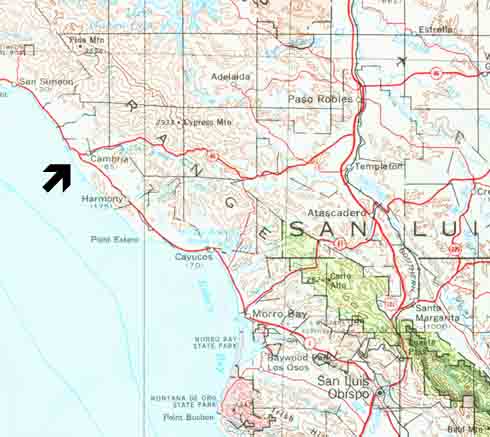
Figure 1. Project Location.
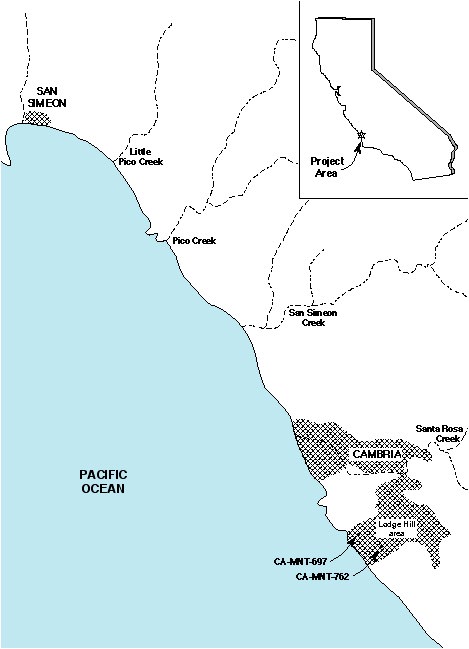
Figure 2. Project Location.
FIELD METHODS
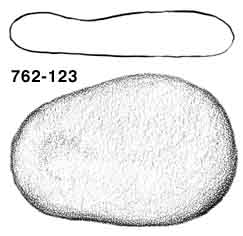 CA-SLO-697
CA-SLO-697
A single 1 x 2 m unit was excavated as mitigation for construction. The depth was minimal; the sloping floor of the unit reached 20 cm on one end and the deepest pockets on the opposite end reached only 35-40 cm.
Pitted stones were the main artifacts recovered (15 out of 20 artifacts). They were weighed and measured, and entered into our computer system for further analysis.
Four abalone shells were submitted to the radiocarbon laboratory at Washington State University for dating.
The collection is curated in the Archival Vault of the Monterey County Historical Society, in Salinas, California.
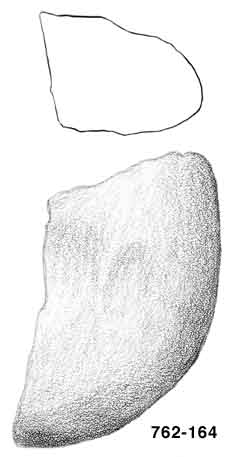 CA-SLO-762
CA-SLO-762
This project was unusual in that no formal units were excavated. Rather, work was limited to the recovery of materials from a dirt pile generated by excavation of foundation trenches.
The principle method used was to shovel the dirt pile, estimated to be between 15 and 25 cubic meters in size, into a pair of electric shaker screens mounted with 1/4 inch mesh screens. The unwashed screenloads of processed materials were then taken to a table where they were rapidly field sorted. Artifacts, bone, and lithic materials were recovered and bagged for further processing, while the bulk of the sample, consisting primarily of shellfish remains and unmodified rock, was returned to the surface of the site. A nonsystematic surface collection of artifacts and relevant cultural materials was also made during the field investigations.
All materials returned from the field (with the exception of the ground stone) were immediately washed and air dried. The ground stone was examined unwashed for selection of specimens for immunological analysis.
In order to obtain additional data on the function of pitted stones, a sample of 24 pitted stones and 1 mortar rim fragment were selected from the ground stone collection and shipped, still unwashed, to Dr. Margaret Newman for immunological analysis. The results of her study are contained in Appendix 1.
The flaked stone materials were submitted to Michael Rondeau of Rondeau Archaeological for analysis. His report appears as Appendix 2.
The pitted stones were weighed and measured, and entered into our computer system for further analysis.
Two abalone shells were submitted to Beta Analytic of Coral Gables, Florida, for radiocarbon analysis.
Finally, the collection is curated in the Archival Vault of the Monterey County Historical Society, in Salinas, California.
RESULTS OF THE INVESTIGATIONS
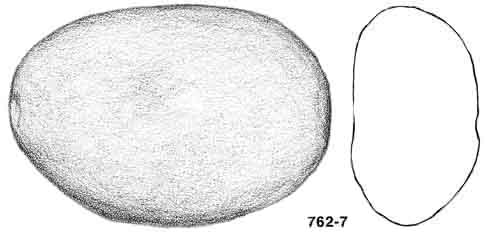
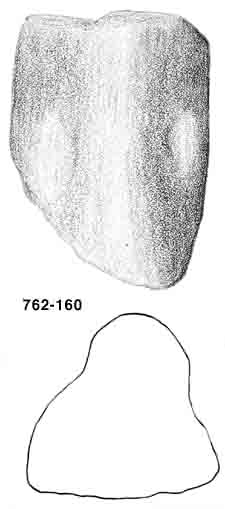 The Pitted Stone
The Pitted Stone
The principle artifact in the collections from CA-SLO-697 and CA-SLO-762 is the ubiquitous pitted stone. Pitted stones have generally been considered as "opportunistic" artifacts; they are fashioned from shale, sandstone, granite, or virtually any other available material or item. At CA-SLO-2, adjacent to the Diablo Canyon Power Plant, 655 pitted stones were found. At that site, pitting was noted on hammerstones, manos, pestles, bowl fragments, and many other artifacts (Greenwood 1972). Pitted stones are most common among the coastal groups of the northern Chumash, but are found to both the north and south of that area.
Although pitted stones are very common in some deposits, we do not know their function. Numerous theories have been advanced to account for these artifacts, but no theory has yet been conclusively documented or even widely accepted. Pitted stones do seem to be associated with the kitchen portions of middens. Further, Greenwood noted that at least half of the specimens at CA-SLO-2 were visibly burned. Gibson (personal communication 1988) further notes that pitted stones are not associated with the non-shell areas of sites (e.g., lithic scatters). For whatever function they fulfilled on the Central California coast, pitted stones must have been an "ideal" tool, as they have been documented through virtually the entire span of human occupation. Greenwood (1972:28) suggested that they might play a role in shellfish processing. In the past we have speculated that they played a role in processing fish (Breschini and Haversat 1988b:47, 1989:69). Given the abundance of these artifacts, and their long duration, it is also possible that they were used for several different purposes associated with exploitation of marine resources.
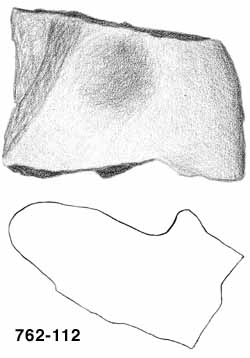 Analyses of Pitted Stones
Analyses of Pitted Stones
In an attempt to shed some additional light on the origins and possible usage of pitted stones, we explored the characteristics of the 92 specimens from these two nearby sites (77 from CA-SLO-762 and 15 from CA-SLO-697).
Basic statistics on the sample, including the mean length, width, thickness, and weight, are depicted in Table 1. Both sites produced almost identical results (with differences averaging about 3.5 percent), which is a surprisingly close agreement given the small size of the sample from CA-SLO-697 (only 15 specimens).
We found that the typical pitted stone in the combined sample measures approximately 8.66 x 6.73 x 3.89 cm (3.4 x 2.7 x 1.5 inches) and weighs approximately 309 g (about 11 ounces). The largest (Cat. No. 697-7) is almost a kilogram (2.2 lbs) in weight, with pits approximately 1 cm in depth. The smallest (Cat. No. 762-123) is a small, flat, smooth pebble with a shallow pit on one side and weighs only 40 g. The majority (47 out of 92 specimens), however, weigh between 200-400 g.
The pits range anywhere from barely perceptible to as much as a centimeter deep (average 2.30 mm). They can be irregular, regular, oval, double, or double/oval. However, if pits occur on both sides of the rock they are generally directly opposite one another and approximately the same depth. The pits are generally centered (73 cases) as opposed to off-center (14 cases).
Table 1. Measurements of Pitted Stones from CA-SLO-762 and CA-SLO-697.
Length, width, and thickness are measured in cm. Weight is measured in g.
| | Length | Width | Thickness | Weight |
| Minimum | 3.70 | 3.73 | 1.29 | 40.7 |
| Maximum | 13.00 | 13.50 | 7.51 | 1,359.5 |
| Mean (both sites) | 8.66 | 6.73 | 3.89 | 309.5 |
| Mean (CA-SLO-697) | 8.44 | 6.98 | 4.08 | 314.2 |
| Mean (CA-SLO-762) | 8.70 | 6.68 | 3.85 | 308.6 |
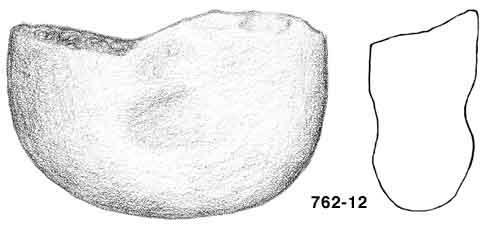
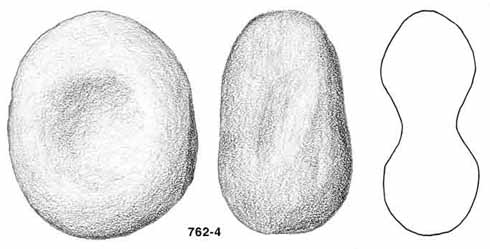
The majority of the stones from which pitted stones in the current collection are fashioned appear to have started as relatively flat, rounded cobbles, but over half have been broken, possibly after pitting but more likely before the pits were fashioned.
Pitted stones are classified in Table 2 as ovoid (e.g., Cat. No. 762-3), quarter round (e.g., Cat. No. 762-170), half round (e.g., Cat. No. 762-12), round, elongated (e.g., Cat. No. 762-104), rectangular (e.g., Cat. No. 762-121), and irregular (e.g., Cat. No. 762-173). As shown in Table 2, the ovoid, quarter round, and half round forms make up the majority of the collection (72.9%).
Table 2. Shapes of Pitted Stones from CA-SLO-762 and CA-SLO-697.
| | Number | Percent |
| Ovoid | 18 | 19.6 |
| Quarter round | 23 | 25.0 |
| Half round | 26 | 28.3 |
| Round | 4 | 4.3 |
| Rectangular | 7 | 7.6 |
| Elongate | 5 | 5.4 |
| Irregular | 9 | 9.8 |
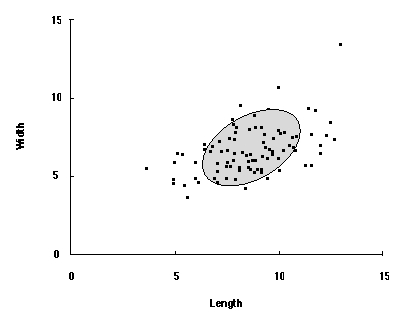
Figure 2. Length vs. Width of 92 Pitted Stones from CA-SLO-697 and CA-SLO-762. The ellipse is a bivariate ellipse centered on the sample means, and including approximately 50% of the specimens. Measurements are in centimeters.
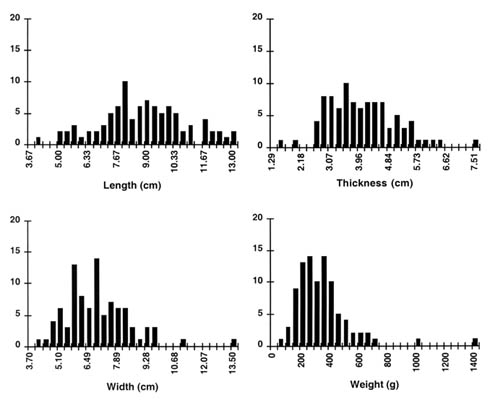
Figure 3. Length, Width, Thickness, and Weight Distributions of 92 Pitted Stones from CA-SLO-697 and CA-SLO-762.
Pits in completely irregular fragments (such as Cat. No. 762-114) are much less common. One pit occurs in a mortar fragment (Cat. No. 762-112). In other sites, pits have been found on manos and other ground stone artifacts. This may represent reuse of broken tool fragments.
The majority of pits appear to have been made in approximately the center of the cobble or cobble fragment, though there are exceptions--usually on irregular stones.
Table 3. Characteristics of Pitted Stones from CA-SLO-697 and CA-SLO-762.
Because of its size and shape, this table will open as a separate window.
A number of the pitted stones have pronounced wear on the edges, suggesting that the flat surfaces in which the pits are fashioned are not the primary working surfaces. This edge wear is particularly noticeable on Cat. No. 762-4.
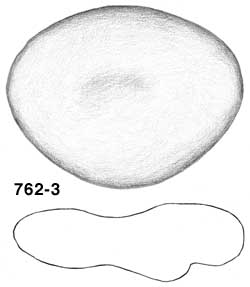
If the flat surfaces with the pits are not the primary working surfaces, then what function do the pits perform? Since most of the pitted stones fit the hand very well, and since most of the wear appears to be around the edges, it is most likely that these stones are used primarily for pounding tasks. This alone, however, does not explain the pits, as generalized pounding tools, without such modification, are found throughout California.
One explanation that may fit these tools is that the pits are used to produce a mechanical advantage, i.e., to make the stone easier to grip, while working with some material which is very slippery. Possible functions could include pounding shellfish (tenderizing abalone or other species), scaling fish, or perhaps processing seaweed. An alternative theory suggested that the pits were used to hold acorns while they were cracked. These alternatives may be narrowed down somewhat based on the immunological studies discussed below and described in detail in Appendix 1.
Temporal Placement
Given the limited number of temporally diagnostic artifacts, the primary means for determining the temporal placement of CA-SLO-762 is radiocarbon dating. Two radiocarbon dates were obtained by Sawyer during his project (the first and fourth), and two additional dates were obtained during the current project (the second and third). These are listed in Table 4, below.
The radiocarbon dates for CA-SLO-697 are also provided. The WSU dates were obtained by the authors, while the two UCR dates were obtained by Gibson.
Table 4. Radiocarbon Determinations from CA-SLO-697 and CA-SLO-762.
These ages represent measured age, and have not been calibrated.
| Age - Range | Lab. No. | Material | Provenience |
CA-SLO-697 |
| 4010 ± 110 | WSU-3900 | Shell-Haliotis r. (1 pc) | Feature 1 |
| 4030 ± 70 | WSU-3903 | Shell-Haliotis r. (1 pc) | Feature 1 |
| 4160 ± 160 | UCR-794 | Shell-Haliotis r. | Unit 3, 30 cm |
| 4160 ± 80 | WSU-3902 | Shell-Haliotis r. (1 pc) | Feature 1 |
| 4370 ± 80 | WSU-3901 | Shell-Haliotis r. (1 pc) | Feature 1 |
| 4900 ± 150 | UCR-795 | Shell-Haliotis r. | Unit 3, 30-40 cm |
CA-SLO-762 |
| 3470 ± 70 | BETA-62287 | Shell-Haliotis r. | Trench, 80 cm |
| 4560 ± 70 | BETA-65727 | Shell-Haliotis r. (1 pc) | Surface pile |
| 4580 ± 70 | BETA-65728 | Shell-Haliotis r. (1 pc) | Surface pile |
| 4650 ± 70 | BETA-62288 | Shell-Haliotis r. | Trench, 50 cm |
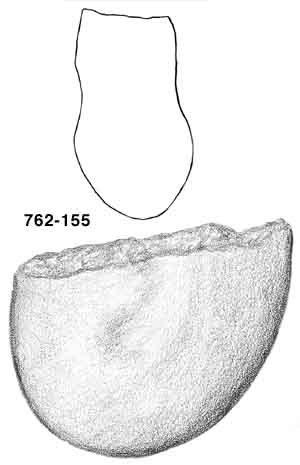
Given the lack of controlled excavation at CA-SLO-762, dating whole abalone shells was selected as the best method for determining the temporal placement of the deposit. The two samples submitted by Sawyer were obtained from 50 and 80 cm below a very disturbed post-grading surface, and the depths below the original surface are questionable. The inversion (an older date obtained from a higher level than a younger date) also supports the possibility that the depths do not reflect original conditions.
The two samples submitted during the current project were from the dirt pile, so their original provenience is, of course, unknown. However, both exhibited a caliche buildup generally associated with the lowermost levels of a deposit. The radiocarbon dates which were obtained suggest that these two samples did indeed associate with the lower levels of the deposit. Given the narrow range for the oldest three dates, the lower portions of the site are probably well represented. However, additional samples would be useful for further exploring the temporal range of the upper portions of the deposit.
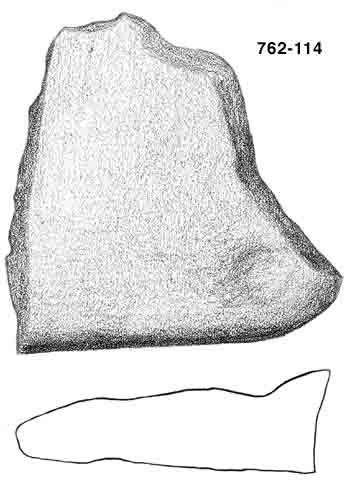
CONCLUSIONS
Our investigations found that CA-SLO-762 has a well-developed "kitchen midden" typical of a habitation site. The depth of the deposit, with the characteristic dark soil, suggests a significant level of activity and possibly a moderate duration of occupation. The lack of excavation units, however, makes it impossible to assess the presence and nature of any features, such as fire hearths or living surfaces. The analysis was limited to the material from two column samples and a surface pile because units would cause additional damage. Significant portions of the site should still be preserved under the house and around the edges of the property. Now that an initial assessment of the site has been made, future studies in the area can address more advanced research questions.
The location of CA-SLO-762 on what is presently a sloping hillside might lead one to speculate that this site is related to the immediately adjacent midden sites, one on top of the hill and one just below this site. However, limited radiocarbon dating indicates that these adjacent prehistoric sites, CA-SLO-177 and CA-SLO-178, are either older or younger than CA-SLO-762 (cf. Breschini, Haversat, and Erlandson 1992). The only other site in the general Lodge Hill area that appears to be largely contemporaneous with CA-SLO-762, based on current radiocarbon dates, is CA-SLO-697.
These two archaeological sites, then, provide our only evidence for exploring prehistoric life in the Lodge Hill area 4,500 years ago. CA-SLO-762 was probably chosen for occupation because of a nearby spring which provided a source of fresh water. The site was sufficiently favorable to its inhabitants to warrant the considerable effort required to lug burden baskets full of ocean resources, including fish, shellfish, and probably seaweed to the site for processing. Other items, such as the siliceous stones from which tools were manufactured, were also imported.

REFERENCES
Breschini, G.S., and T. Haversat. 1988a. Archaeological Investigations at CA-SLO-99, Pismo Beach, San Luis Obispo County, California. Coyote Press Archives of California Prehistory 26.
Breschini, G.S., and T. Haversat. 1988b. Archaeological Excavations at CA-SLO-7 and CA-SLO-8, Diablo Canyon, San Luis Obispo County, California. Coyote Press Archives of California Prehistory 28.
Breschini, G.S., and T. Haversat. 1989. Archaeological Excavations at CA-MNT-108, at Fisherman's Wharf, Monterey, Monterey County, California. Coyote Press Archives of California Prehistory 29.
Breschini, G.S., T. Haversat, and J. Erlandson. 1992. California Radiocarbon Dates. Seventh Edition. Coyote Press, Salinas.
Breschini, G.S., T. Haversat, and R.P. Hampson. 1983. A Cultural Resources Overview of the Coast and Coast-Valley Study Areas [California]. Submitted to Bureau of Land Management, Bakersfield.
Gillespie, R. 1984. Radiocarbon User's Handbook. Oxford University Committee for Archaeology, Monograph 3.
Greenwood, R.S. 1972. 9000 Years of Prehistory at Diablo Canyon, San Luis Obispo County, California. Occasional Papers of the San Luis Obispo County Archaeological Society 7.
Kroeber, A.L. 1925. Handbook of the Indians of California. Bureau of American Ethnology Bulletin 78.
Moratto, M.J. 1984. California Archaeology. Academic Press, Orlando.
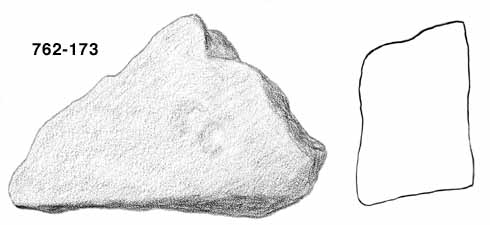
APPENDIX 1
Immunological Analysis of Artifacts from Site CA-SLO-762,
Cambria, San Luis Obispo County, California
by
Margaret Newman
In recent years it has been recognized that lithic and ceramic artifacts often retain traces of protein residues from the time of their original use. Studies have demonstrated that by the use of biochemical and immunological methods, the species of origin can be identified to at least the family level of identity (Briuer 1976; Broderick 1979; Downs 1985; Hyland et al. 1989; Kooyman et al. 1991; Newman 1990; Newman and Julig 1989; Newman et al. 1993; Shafer and Holloway 1979; Yohe et al. 1991). The identification of animal residues in soil samples has been demonstrated recently from a site in the Lower Mackenzie River Valley, Northwest Territories, Canada and from a site in southern California (Newman et al. 1993; Nolin et al. n.d.). Data acquired by these means can be used in the reconstruction of prehistoric subsistence patterns, to recreate past environments, and possibly in identifying task specific artifacts.
Although various immunological methods have been used, the basis of all is the antigen-antibody reaction first observed in the classic precipitin test in the late 1800s. Following its discovery, the test quickly achieved integrity in the fields of clinical and forensic medicine and has been used extensively in medico-legal work since the beginning of this century (Gaensslen 1983). Although the successful identification of protein residues is dependent on their condition, forensic studies have demonstrated that proteins are extremely robust molecules and can withstand harsh treatment while still retaining their antigenicity and biological activity (Arquembourg 1975; Haber 1965; Gaensslen 1983; Lee and DeForest 1976; Macey 1979; Sensabaugh et al. 1971, among others). The fact that vivid results from the analysis of old and severely denatured proteins are obtained in forensic medicine is of special relevance to archaeology where "old and denatured" proteins are the norm. The sensitivity and specificity of precipitin reactions makes them an extremely effective method for the detection of trace amounts of protein (Kabat and Meyer 1967:22).
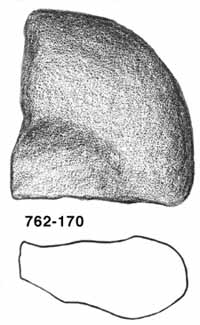
Methods and Materials
Cross-over immunoelectrophoresis (CIEP) is used for the identifications of bloodstains, body tissues, and fluids in medico-legal work (Culliford 1964; Gaensslen 1983) and is the method of analysis used in this laboratory. Minor adaptations to the original method were made following procedures used by the Royal Canadian Mounted Police Serology Laboratory (Ottawa) and the Centre of Forensic Sciences (Toronto). The test is based on the principles of the precipitin test but affords a higher degree of sensitivity and can identify 10-8 g of protein (Culliford 1964; Gaensslen 1983). The procedure is discussed fully in Newman and Julig (1989).
Twenty-five groundstone artifacts recovered from archaeological site CA-SLO-762, California, were sent for immunological analysis. Soil samples, taken from bags containing the artifacts were removed and used as control samples. It is important that control soil samples be included in all analyses as contaminants in soils, such as bacteria, tannic acid, and iron chlorates, may result in nonspecific precipitation of antisera (Gaensslen 1983).
Possible residues were removed from the artifacts using a 5% ammonium hydroxide solution. This has been shown to be the most effective extractant for old and denatured bloodstains and does not interfere with subsequent testing (Dorrill and Whitehead 1979; King and Cleevely 1969). Artifacts were placed in shallow plastic dishes and 1.0 mL of the 5% ammonia solution applied directly to the center depression of each. The solutions were mixed well with wooden applicator sticks and allowed to remain in contact for thirty minutes. The resulting ammonia solutions were removed with pasteur pipettes, placed in individual numbered plastic vials and refrigerated prior to further testing. One milliliter 1.0 mL) of Tris buffer (pH 8.0) was added to approximately 1 g amounts of each soil sample, mixed well and allowed to extract for 24 hours at 4° C to prevent bacterial contamination. The resulting supernatant fluids were removed and tested only against pre-immune serum.
All extracts were first tested against pre-immune serum (i.e., serum from a non-immunized animal). A positive result against pre-immune serum could arise from non-specific protein interaction not based on the immunological specificity of the antibody (i.e., nonspecific precipitation). No positive results were obtained and the artifact extracts were tested against the antisera shown in Table 1.
Table 1. Antisera Used in Analysis.
| Antisera | Source |
| Anti-bear | Organon Teknika |
| Anti-cat | Forensic medicine |
| Anti-chicken | Forensic medicine |
| Anti-deer | Forensic medicine |
| Anti-dog | Forensic medicine |
| Anti-guinea-pig | Forensic medicine |
| Anti-mouse | Forensic medicine |
| Anti-rabbit | Forensic medicine |
| Anti-trout | University of Calgary |
| Anti-leopard shark | Lowenstein |
| Anti-sturgeon | U.C. San Francisco |
Except where noted, antisera are obtained from commercial sources and were developed specifically for use in Forensic Medicine. Where necessary these sera are solid phase absorbed to eliminate species cross-reactivity, however, they are polyclonal, that is they recognize epitopes shared by closely related species. For example, anti-deer will give positive results with other members of the Cervidae family such as deer, moose, elk, and caribou as well as with pronghorn (Antilocapridae family). The trout antiserum, raised at the University of Calgary, is polyclonal and will recognize most members of the Salmonidae family. The antisera to shark and sturgeon (Lowenstein) are species-specific. Immunological relationships do not necessarily bear any relationship to the Linnaean classification scheme although they usually do (Gaensslen 1983).
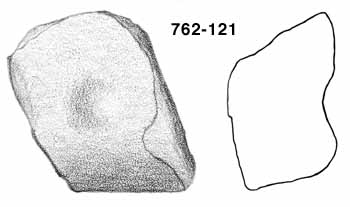
Results
The results of CIEP analysis are shown in Table 2 and discussed below.
Positive results to trout antiserum were obtained on three artifacts (Cat. nos. 762-160, -171, and -173). A positive result to this antiserum could represent any member of the Salmonidae family or possibly other species of fish not tested for when the antiserum was produced.
No other positive results were obtained in this analysis. The absence of identifiable proteins on artifacts may be due to poor preservation of protein or that they were used on species other than those encompassed by the antisera. It is also possible that the artifacts were not utilized.
Table 2. Results of CIEP Analysis.
| No. | Artifact | Cat. No. | Results #1 | Results #2 |
| 1 | Bi-pitted stone (Serum #1) | 762-0151 | | |
| 2 | Bi-pitted stone (Serum #2) | 762-0152 | | Clam |
| 3 | Bi-pitted stone (Serum #3) | 762-0153 | | |
| 4 | Bi-pitted stone (Serum #4) | 762-0154 | | |
| 5 | Bi-pitted stone (Serum #5) | 762-0155 | | Clam |
| 6 | Bi-pitted stone (Serum #6) | 762-0156 | | |
| 7 | Bi-pitted stone (Serum #7) | 762-0157 | | |
| 8 | Bi-pitted stone (Serum #8) | 762-0158 | | |
| 9 | Bi-pitted stone (Serum #9) | 762-0159 | | |
| 10 | Bi-pitted stone (Serum #10) | 762-0160 | Trout | Clam |
| 11 | Bi-pitted stone (Serum #12) | 762-0161 | | |
| 12 | Bi-pitted stone (Serum #13) | 762-0162 | | |
| 13 | Bi-pitted stone (Serum #14) | 762-0163 | | Clam |
| 14 | Bi-pitted; both pits on one side (Serum #15) | 762-0164 | | Clam |
| 15 | Pitted stone (Serum #16) | 762-0165 | | |
| 16 | Bi-pitted stone Serum #17) | 762-0166 | | |
| 17 | Bi-pitted stone, end-battered (Serum #18) | 762-0167 | | |
| 18 | Bi-pitted stone, end-battered (Serum #19) | 762-0168 | | Clam |
| 19 | Bi-pitted stone, end-battered (Serum #20) | 762-0169 | | |
| 20 | Bi-pitted stone, 2 pits each side (Serum #21) | 762-0170 | | |
| 21 | Pitted stone (Serum #22) | 762-0171 | Trout | |
| 22 | Bi-pitted stone (Serum #11) | 762-0172 | | |
| 23 | Bi-pitted stone (Serum #23) | 762-0173 | Trout | |
| 24 | Bi-pitted stone (Serum #24) | 762-0174 | | |
| 25 | Mortar rim fragment (Serum #25) | 762-0175 | | Clam |
The "Results #1" column contains the initial results of the analysis. The "Results #2" column includes additional results obtained several months later.
|
References Cited
Arquembourg, P.C. 1975. Immunoelectrophoresis: Theory, Methods, Identification, Interpretation. S. Karger, Basel-Munchen.
Culliford, B.J.1963. Precipitin Reactions in Forensic Problems. Nature 201:1092-1094.
Dorrill, M. and P.H. Whitehead. 1979. The Species Identification of Very Old Human Bloodstains. Forensic Science International 13:111-116.
Gaensslen, R.E. 1983. Sourcebook in Forensic Serology, Immunology, and Biochemistry. U.S. Department of Justice, Washington, D.C.
Haber, E. 1964. Recovery of Antigenic Specificity after Denaturation and Complete Reduction of Disulfides in a Papain Fragment of Antibody. Proceedings of the National Academy of Sciences 52:1099-1106.
Heron, C.L., R.P. Evershed, L.J. Goad and V. Denham. 1991. New Approaches to the Analysis of Organic Residues from Archaeological Remains. In Archaeological Sciences 1989, P. Budd, B. Chapman, R. Janaway, and B. Ottaway, eds., pp. 332-339. Oxbow Monograph 9.
Hyland, D.C., J.M. Tersak, J.M. Adovasio and M.I. Siegel. 1990. Identification of the Species of Origin of Residual Blood on Lithic Material. American Antiquity 55:104-112.
Kabat, E.A. and M.M. Meyer. 1967. Experimental Immunochemistry. Thomas, Springfield, Illinois.
Kind, S.S. and R.M. Cleevely. 1969. The Use of Ammoniacal Bloodstain Extracts in ABO Groupings. Journal of Forensic Sciences 15:131-134.
Kooyman, B., M.E. Newman and H. Ceri. 1992. Verifying the Reliability of Blood Residue Analysis on Archaeological Tools. Journal of Archaeological Science 19(3):265-269.
Lee, H.C. and P.R. DeForest. 1976. A Precipitin-Inhibition Test on Denatured Bloodstains for the Determination of Human Origin. Journal of Forensic Sciences 21:804-809.
Macey, H.L. 1979. The Identification of Human Blood in a 166-Year-Old Stain. Canadian Journal of Forensic Sciences 12(4):191-193.
Newman, M.E. 1990. The Hidden Evidence from Hidden Cave, Nevada. Ph.D. dissertation, University of Toronto, Canada.
Newman, M.E., and P. Julig. 1989. The Identification of Protein Residues on Lithic Artifacts from a Stratified Boreal Forest Site. Canadian Journal of Archaeology 13:119-132.
Newman, M.E., R.M. Yohe, H. Ceri and M.Q. Sutton. 1993. Immunological Protein Residue Analysis of Nonlithic Archaeological Materials. Journal of Archaeological Science 20:93-100.
Nolin, L., J. K.G. Kramer and M.E. Newman. n.d. Detection of Animal Residues in Humus Samples from a Prehistoric Site in the Lower Mackenzie River Valley, Northwest Territories. Journal of Archaeological Science. In press.
Royal Canadian Mounted Police. 1983. Methods Manual, Serology Section. Ottawa, Ontario.
Sensabaugh, G.F., A.C. Wilson and P.L. Kirk. 1971. Protein Stability in Preserved Biological Remains. International Journal of Biochemistry 2:545-568.
Yohe, R. M., M.E. Newman and S.J. Schneider. 1991. Immunological Identification of Small-Mammal Proteins on Aboriginal Milling Equipment. American Antiquity 56(4):659-666.
APPENDIX 2
Analysis of the Flaked Stone Assemblage from CA-SLO-762, Cambria, San Luis Obispo County, California, by Michael F. Rondeau and Vicki L. Rondeau.





 CA-SLO-697
CA-SLO-697 CA-SLO-762
CA-SLO-762
 The Pitted Stone
The Pitted Stone Analyses of Pitted Stones
Analyses of Pitted Stones









